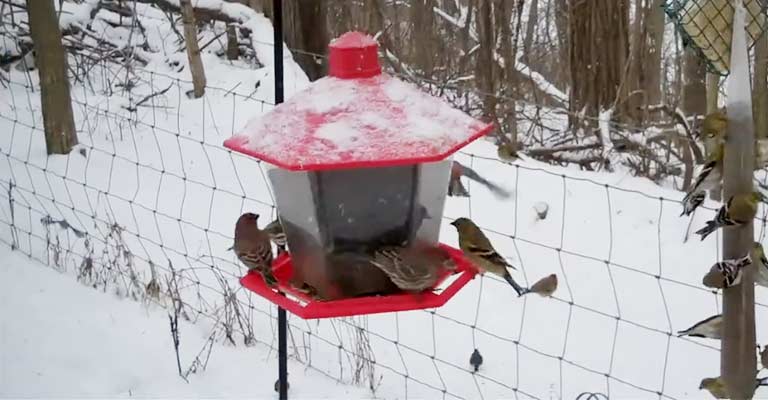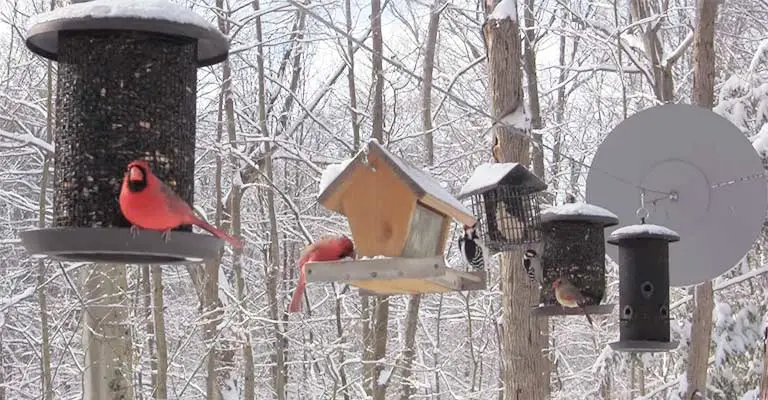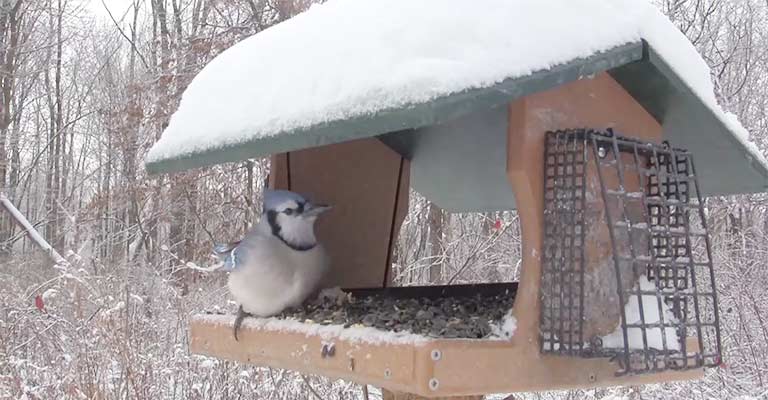Winter transforms our landscapes into a chilly haven, challenging both us and our feathered friends. Attracting birds to a feeder in winter requires thoughtful strategies to provide sustenance and warmth during the harsh season.
This guide explores how to attract birds to a feeder in winter when nature’s resources are scarce.
From high-energy foods to heated water sources, these tips aim to foster a winter sanctuary that not only nourishes birds but also allows us to witness the beauty of avian life against the backdrop of a winter wonderland.

How To Attract Birds To A Feeder In Winter?
Winter brings unique challenges for attracting birds to feeders as natural food sources become scarce. Implementing strategies tailored to the colder months ensures a continuous flow of feathered visitors.
Here are some effective ways to attract birds to a feeder in winter
High-Energy Foods
Provide high-energy foods like suet, black oil, sunflower seeds, and peanuts. These calorie-rich options sustain birds during the winter months when they need additional energy to combat the cold.
Heated Bird Baths
Install a heated bird bath to offer birds a reliable source of unfrozen water. Access to water is crucial in winter, and a heated bath becomes a magnet for various species seeking hydration.
Sheltered Feeder Placement
Position feeders in sheltered locations, protected from harsh winds and snow. Birds are more likely to visit feeders that offer a sense of security and relief from winter weather conditions.
Variety of Feeder Types
Incorporate various feeder types, such as hopper feeders, tube feeders, and suet cages. Different species have distinct feeding preferences, and a diverse array of feeders accommodates a broader range of winter visitors.
Winter Landscaping
Maintain winter-friendly landscaping with evergreen trees and shrubs. These provide natural shelter and perching spots, attracting birds to the feeder while ensuring they have nearby refuge from the cold.
Regular Feeder Cleaning
Keep feeders clean and free of snow and ice. Regularly check and replenish food, as winter conditions can impact accessibility. Clean, well-maintained feeders are more appealing to birds.
Provide Grit and Gravel
Scatter grit and gravel near the feeder. Birds consume grit to aid in digesting seeds, which is especially important during winter when their diet may include more hard-to-digest foods like seeds and nuts.
What Is The Best Bird Feeder For Winter Birds?

Choosing the right bird feeder for winter is crucial to ensure the well-being of our feathered friends during the colder months. Winter birds have specific needs, and the right feeder can provide them with essential sustenance.
Here are the types of bird feeders, each uniquely suited to attract and accommodate winter birds:
Hopper Feeders
Hopper feeders are ideal for winter as they have a roof to protect seeds from snow and rain. Their larger capacity accommodates more seed, providing a consistent food source for birds like cardinals and finches throughout the winter.
Tube Feeders with Metal Ports
Tube feeders with metal ports prevent moisture buildup and freezing, making them excellent choices for winter. The design allows small birds, such as chickadees and nuthatches, to cling and feed even in cold weather.
Suet Feeders
Suet feeders are essential for winter bird feeding, offering a high-energy food source. These feeders cater to woodpeckers, titmice, and other insect-eating birds, providing them with the necessary calories to withstand the cold.
Platform Feeders with Roofs
Platform feeders with roofs offer an open feeding space while protecting seeds from snow. They attract a variety of ground-feeding birds like juncos, sparrows, and doves, creating a winter buffet for different species.
Nyjer (Thistle) Seed Feeders
Nyjer seed feeders are perfect for attracting finches, siskins, and other small winter birds. The tiny seeds are easily dispensed, and the feeders can be designed with perches suitable for finch-sized birds.
Heated Bird Baths
While not traditional feeders, heated bird baths are crucial for winter bird survival. Providing liquid water in freezing temperatures is challenging, and a heated bath ensures birds have access to hydration, attracting them to your winter bird-friendly space.
Window-Mounted Feeders
Window-mounted feeders bring birds up close for winter birdwatching. These compact feeders attract chickadees, titmice, and other small birds, allowing you to enjoy winter bird activity from the warmth of your home.
Which Kind Of Feeder Birds Don’t Like In Winter?

While winter bird feeding is a joyous activity, it’s essential to be mindful of certain feeder types that might not cater to the needs or preferences of birds during the colder months.
Here are the types of feeders that birds may not favor during winter:
Open Tray Feeders
Open tray feeders, while popular in other seasons, may be less attractive in winter as they expose food to snow and moisture. Birds often prefer feeders with roofs or shelters that protect the seed from the elements.
Large Tube Feeders
Large tube feeders may not be as appealing in winter because they can accumulate snow and ice, making it difficult for birds to access the seeds. Smaller, more manageable tube feeders are often preferred during cold weather.
Mesh or Net Feeders
Mesh or net feeders, especially those with fine openings, can trap and hold onto snow, rendering the seeds inaccessible to birds. Birds may opt for easier-to-reach food sources during winter, avoiding mesh feeders.
Ground-Level Feeders
Feeders placed directly on the ground may be less attractive in winter, as snow accumulation can bury the food. Birds may prefer elevated feeders that remain above the snow line for easier access to seeds.
Non-Heated Bird Baths
While not a feeder, non-heated bird baths may discourage birds during winter. Birds require liquid water, and if the bath is not heated, it can freeze, limiting their access to a vital water source.
Overly Crowded Feeders
Feeders with excessive seeds or those that become overcrowded with birds may be less appealing in winter. Birds can feel stressed in large crowds, and providing space for them to feed comfortably becomes crucial during colder months.
Dull or Unprotected Feeders
Feeders that lack protection against the elements or appear dull and uninspiring may be less enticing in winter. Birds are more likely to visit well-maintained, vibrant feeders that offer a sense of security and reliability.
By being aware of these considerations, you can fine-tune your winter bird feeding setup to be more appealing and accommodating to the specific needs of birds during the colder months.
FAQs
Is water essential in attracting birds during winter?
Yes, water is crucial. Install a heated bird bath to offer liquid water, especially when natural water sources freeze, providing birds with a vital hydration spot.
Are there specific winter-friendly feeder types?
Yes, opt for hopper feeders, suet cages, and heated bird baths. These accommodate winter conditions, providing accessible food and water for birds.
How do I prevent seeds from freezing in the feeder?
Choose feeders with protective features like roofs or baffles. Regularly clean and replenish seeds to prevent moisture buildup and freezing.
Can I attract different bird species in winter?
Absolutely. Varied foods and feeder types attract a diverse range of winter birds, including chickadees, cardinals, woodpeckers, and finches.
Is it necessary to place feeders in sheltered locations?
Yes, positioning feeders in sheltered spots protects birds from harsh winter winds and snow, making the feeding station more inviting.
Conclusion
In the serene quietude of winter, the art of attracting birds to a feeder becomes a heartening endeavour. By implementing strategies tailored to the specific needs of winter birds, we create a lifeline for our feathered companions.
As snow blankets the landscape, the careful placement of feeders, the provision of energy-rich foods, and the allure of heated baths transform our outdoor spaces into avian oases.
Winter birdwatching, made possible by these thoughtful measures, becomes a source of joy and connection to the resilient spirits of our winged neighbours amid the cold embrace of the season.